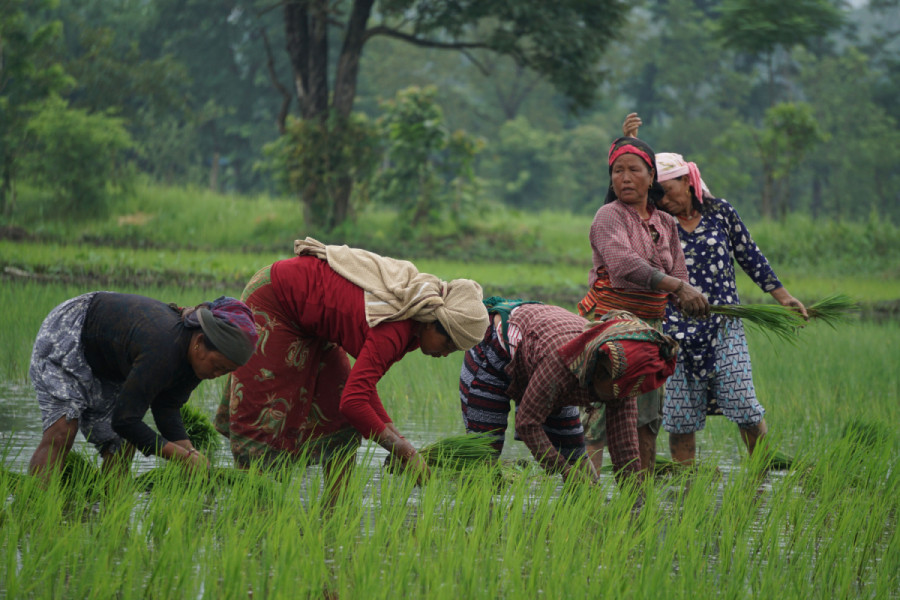Columns
Reviving Nepal's agriculture
Mixed farming can boost Nepal’s income, food security and resilience to climate change.
Nilhari Neupane & Sanju Koirala
Nepal’s agriculture is largely dominated by small and medium holder farmers practising a mixed farming system (MFS) which includes multiple cropping practices like growing vegetables and fruits and raising livestock. This system typically involves a strong integration of crop and livestock production, where livestock provides manure for crop production and crop residues provide feed for livestock. MFS is predominant in the mid-hill and mountain regions of Nepal where opportunities for mono-cropping and commercial farming are limited due to small land holding size and irrigation, transportation and market constraints.
According to the Agriculture Census of Nepal 2011-12, there are approximately 3.8 million households depending on agriculture, out of which 80 percent have less than 1 hectare and are classified as marginal and subsistence farmers. These households have access to approximately 47 percent of all cultivated land and are expected to be following MFS. The remaining 20 percent of the families, with access to 53 percent of the cultivated land, are involved in commercial farming or monoculture. MFS is primarily practiced in rain-fed environments on fragmented land in the mid-hills and the mountains.
Disappearing workforce
The government and other stakeholders have paid less attention to improving MFS due to which agricultural productivity has remained stagnant. Changes in climatic factors like temperature, solar radiation and precipitations have affected crop production. The low yields do not cover the cost of cultivation. Consequently, the agriculture workforce is migrating internally and externally in search of alternative livelihood options. According to the National Population Census 2021 preliminary result, 2.1 million Nepalis are living abroad. This means one in every three households had at least one member absent or living outside Nepal. The out-migration of males has increased the work burden of women and elderly farmers. Increasingly, women from many migrant households are also migrating to the cities to secure better education for their children.
The alarming increase in fallow land is a direct consequence of the decrease in agricultural labour. Recent reports show that a significant 33 percent of farm lands remains unused, especially in the mid-hills and mountains. Although labour migration has increased the inflow of remittance, research indicates that one-third of this money is spent on buying food for the family. If agricultural productivity is not increased, labour migrants will end up spending their hard-earned money merely to feed their families back home. This also shows that Nepalis are switching from farm grown food to market purchased food because it is cheaper to buy food than grow it. The consequent rise in food imports has widened the agriculture trade deficit. This has major implications on household food and nutritional security and the country's economy. According to a recent Food and Agriculture Organisation (FAO) report, 13.6 percent of Nepalis suffered from severe food insecurity in 2021. If Nepal can produce enough food to feed its population, it can save $2 billion annually.
The challenges in the agriculture sector indicate a pressing need to rethink the existing agriculture system. In the context of growing labour migration, feminisation of agriculture and increased fallow land, sustainable intensification of mixed farming systems (SIMFS) can be a vital strategy. SIMFS has the potential to enhance the current mixed farming system by utilising the same quantity of natural resources and employing effective crop management and animal husbandry techniques.
Government policies have overlooked the needs of farmers practising mixed farming and prioritised commercial farming, which promotes mono-cropping and use of herbicides and improved crop varieties by providing incentives. Increased use of agro-chemicals is causing contamination of soil and water resources and higher levels of pesticide residues in farm products.
Currently, policies, institutions and technologies are focused more on able-bodied, adult male farmers and less on women and elderly farmers. Policies should focus on improving both practices since farmers cultivate on different scales (large, medium, and small) for different purposes. Policies must also address the needs of female and elderly farmers whose agricultural responsibilities are increasing.
With policy, programme and technological interventions, SIMFS may provide an important opportunity to upscale agro-ecological innovations and improve the livelihoods of resource-poor farmers. This approach can also address environmental problems besides establishing women and elderly-friendly farming practices. However, it is crucial to understand what the farmers want and what they can do. Interventions planned, designed and executed using a participatory approach will be more sustainable than those decided using a top-down approach.
Empirical evidence obtained from pilot programmes conducted in different parts of South Asia shows that SIMFS produced a 20-30 percent higher yield than traditional methods. SIMFS has a positive impact on the environment, and it also helps farmers recover from seasonal shocks like droughts and floods, and external shocks like market failures.
The SIMFS concept is relatively new to Nepal, and appropriate typologies suitable for different agro-ecological zones have not been well identified. To address this issue, pilot activities are being designed and executed by Consultative Group on International Agricultural Research (CGIAR) members the International Water Management Institute (IWMI) and the International Rice and Wheat Improvement Centre (CIMMYT) in collaboration with local governments in Haleshi Tuwachung Municipality, Khotang and Gurbhakot Municipality, Surkhet.
Long-term strategy
The programme is presently consulting with local farmers to understand the existing farming system, the challenges and opportunities of MFS, and the potential interventions applicable in the area. Based on the farmers’ inputs, interventions will be piloted and scaled up in other areas. The research findings are expected to provide suggestions and policy feedback to the government of Nepal to scale up SIMFS.
Sustainable intensification of mixed farming is a crucial strategy for ensuring food security and improving livelihood opportunities of small holders while minimising environmental impacts. To make this happen, government strategies should provide an inclusive policy environment to streamline small holders and marginal farmers in farming, encourage private sector collaboration and attract market players. The government must prioritise sustainable intensification as a long-term strategy for improving food security and livelihoods and strengthening resilience to climate change.




 5.47°C Kathmandu
5.47°C Kathmandu
















